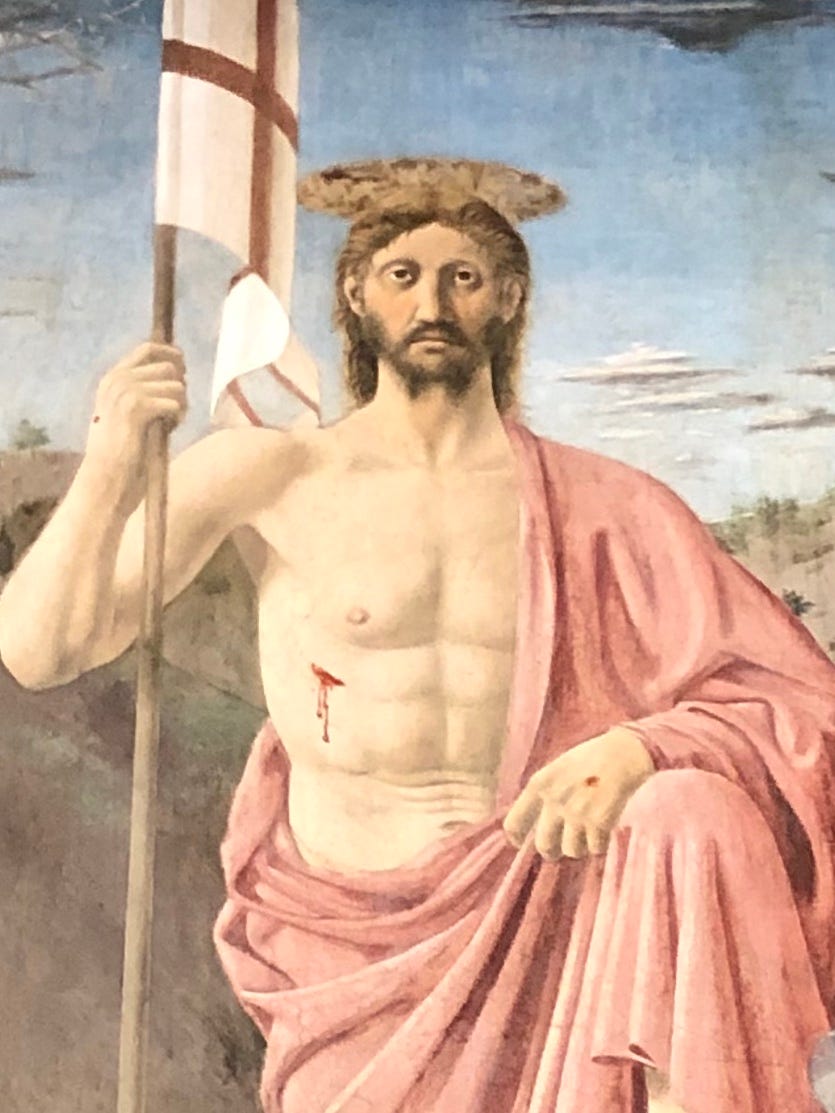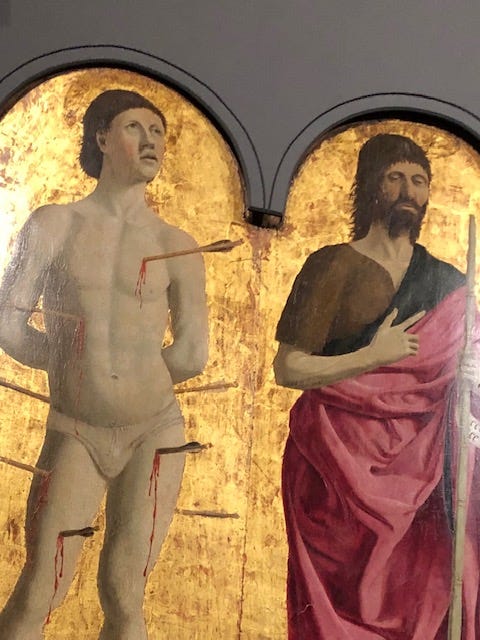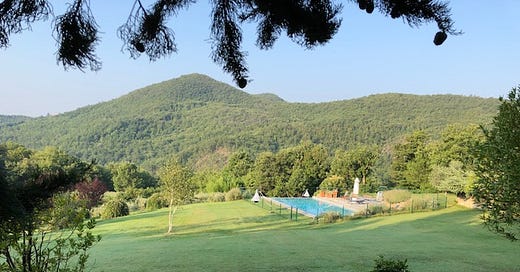
Photo: L.A. Hickey
A magnet for foodies and art lovers, Tuscany’s landscape alone is the stuff of fairytales and I was quite happy to do nothing but sit with a glass of wine and enjoy the splendid views of this beautiful wooded countryside.
My friend and host had other ideas, ’I want to take you to Sansepolcro,’ said John, and with that remark hands me a 1925 essay by Aldous Huxley about an extraordinary fresco by the early Rennaisance painter, Piero Della Francesca.
‘We need no imagination to help us figure its beauty; it stands there before us in entire and actual splendour, the greatest picture in the world,’ writes Huxley.
I want to read the rest of the essay but am called away to do a household chore. John hands me a large glass flagon. ‘Can you go and fill this for me?’ as he directs me to the Spring.
I walk up the long driveway lined with dark firs and then down the road, not very far, where I find a beautiful spring that bubbles forth from the side of a densely wooded hill. The water shoots out in an ever-ending stream. Coming from drought-ridden Australia, these ever flowing crystal waters seem magical and I want to bathe in them. I cup my hands and take a drink. I cup my hands again and pour the cold water over my head, then rub it on my face and limbs. I feel like a priestess administering some sacred rite and almost forget the empty flagon I’ve left on a rock.
Totally refreshed, it’s time for our drive to Sansepolcro. There are four of us going on this little excursion – John, his son, and a university friend who is holidaying from England.
Our aim is to see The Resurrection by Piero della Francesca, Aldous Huxley’s ‘greatest painting in the world’ for in his view it easily eclipsed other great Rennaisance paintings such as Botticelli’s Primavera. (He goes so far as to say he would quite happily burn all of Botticelli’s paintings if it meant saving those by Piero della Francesca.)

Photo: L A. Hickey
In Huxley’s time, back in the 1920’s, getting to Sansepolcro was a 7-hour bus trip from Florence so it’s hardly surprising that this painting was overlooked by the tourist masses. But times have changed and now it’s an easy one-and-a-half hour car or train ride to get there. Still, crowds of art lovers have not yet swamped this little town to the same degree as they do in Florence or Pisa.
I’d arrived in Italy at the height of the tourist season and getting to see a great work of art was sometimes a feat of logistics. In Milan I had tried to see Leonardo’s The Last Supper but was informed I should have bought my ticket three months prior, such was the demand by tourists to glimpse this famous, fading fresco.
As we meander down through the backroads, I wonder what kind of queue we’d find at Sansepolcro. And will we just be turned away for not booking our tickets in advance?
Originally founded by pilgrims, Sansepolcro is a walled 11th century town situated in a valley in the upper reaches of the Tiber river. Piero della Francesca’s fresco is located in the Museo Civico de Sansepolcro. Yes, there’s a fee to see them but surprisingly, hardly anyone else is there. How could this possibly be? After all, I had got used to waiting in long queues of tourists, for example, in Venice to see St Mark’s or in Padua to see Giotto’s frescoes and presumed it would be the same here.
A hush comes over the four of us as we step into the hall and examine the powerful composition of Christ, awake to the world, whilst those around him slept. We murmur to each other – isn’t this a message for our times (as the human race walks blindly towards its own extinction)?
There is no doubt, this painting by Piero della Francesca is a work of genius. I remembered studying it back in high school, but the image I was then shown was a black and white grainy photograph which barely prepared me for what I am now seeing.
‘Piero has made the simple triangular composition symbolic of the subject,’ writes Huxley It’s a Christ ‘…preparing to set out into the world. No geometrical arrangement could have been more simple or more apt. But the being who rises before our eyes is more like a Plutarchian hero than the Christ of conventional religion. The body is perfectly developed, like that of a Greek athlete, so formidably strong that the wound in its muscular flank seems somehow an irrevelance. The face is stern and pensive, the eyes cold. The whole figure is expressive of physical and intellectual power.’

And perhaps it’s this representation of an empowered Christ that makes his interpretation so compelling. There are other fascinating details too, for example, the sleeping Roman in the brown tunic is a self-portrait of Piero himself.
Finding and appreciating the work of Piero della Francesca is only one part of this story. The other is a man called Tony Clarke who, during World War 2, was an officer with the British army stationed above the town. He received an order to shell the town and destroy these buildings that were providing cover to the German troops. However, before executing the order, he suddenly remembered Aldous Huxley’s essay and that there was a priceless work of art here in Sansepolcro and possibly within this very building. Could he knowingly bring himself to destroy such a beautiful fresco?
So, fully aware that he was risking a court martial for his defiance, he resisted carrying out the order, convincing his superiors that after a period of careful surveillance there were no Germans left in the town.
You can read the full story of Tony Clarke’s action on the BBC archive here.
https://www.bbc.com/news/magazine-16306893
For those interested in historical research, it’s a story worth reading for the author was chasing a completely different narrative about Graham Greene when he stumbled upon Tony Clarke’s story in a wartime diary.
There are other delights to be found at the Museum too such as a fresco fragment of St Julian, also by Piero della Francesca.

Photo: L A. Hickey

Photo: L A. Hickey
And finally, apart from The Resurrection the other significant fresco by Piero della Francesca in the Museo Civico di Sansepolcro, is the Polyptych of the Madonna della Misericordia (Virgin of Mercy) in which a giant Madonna enfolds her followers in her protective mantle. Other panels in the polyptych including figures of saints, such as St Sebastian below, and scenes from Christ’s life.

Photo: L A. Hickey
Lying in bed that night there was so much to think about. I understand why there are art holiday tours that do nothing but follow the footsteps of Piero della Francesca and his work.
Under the autumn moon, somewhere in the distance wolves began to howl and I knew this was the fairytale I had been dreaming of.




A captivating and timeless story Amanda and one that gives us all hope for humanity, culture and no queues! I too loved the water spring - a cleansing before your visit.
you write so fluently and make the history alive.